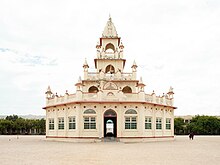Arya Kanya Gurukul situated at Porbandar, Gujarat, is a girls K-12 boarding school in India.[1][2][3]

History
editThe school was set up in 1936 by Gujarati industrialist and philanthropist, Shri Nanji Kalidas Mehta, the founder of Mehta Group. A deep association with Gandhiji and inspired by the Arya Samaj leaders led to the founding of the school.[4][1][2][3][5][6]
Nanji Kalidas was deeply influenced by Mahatma Gandhi and principle of Arya Samaj and he therefore made foundation stone of Gurukul to be laid by a Scheduled Caste girl, a revolutionary step in those times.[7] The school have been visited by dignitaries like Dr. Rajendra Prasad, Dr. Radhakrishnan, Giani Zail Singh, Pt. Jawaharlal Nehru, Smt. Indira Gandhi, Shri Morarji Desai, Shri Rajiv Gandhi, Smt. Sonia Gandhi and more recently, the President Mrs. Pratibha Patil.[1][8]
Arya Kanya Gurukul equips girls to lead fulfilled and purposeful lives by providing an all-round
education based on Vedic values.
Ideology of Gurukul
editGuru in Sanskrit means teacher and kul translates as domain. The Gurukul system is an ancient system of education where students live with their teacher or Guru who would guide their holistic development - the mind, body and spirit. The relationship of a guru and his shishya or pupil is a hallowed concept in Hinduism.
Nanji Kalidas Mehta was a firm believer in women's education and felt a dire need for development in this area in Saurashtra. He felt educating the girl child would help the balanced growth of a society and the growth of a family. The Arya Kanya Gurukul welcomes girls from all walks of life and social strata.
The education system at Gurukul is a blend of Vedic heritage and modern educational systems with an orientation towards science and technology based on Arya Samaj principles.[1][2][3][9][10]
Campus
editThe school complex is set amidst 90 acres of sylvan surroundings on the fringes of the city between the Arabian Sea and the blue Barda Hills. Every morning, 900 girls gather in the Prarthana Mandir to recite their daily prayers and perform the 'yajna', a religious ceremony that harks back to Vedic times.
Dr. Savitaben 'Didiji' Mehta
editOnce Sheth Nanji Kalidas Mehta had established this much needed educational institution, a need was felt for someone responsible to head the institution. His eldest daughter volunteered and made it her lifelong mission to achieve success and excellence for Arya Kanya Gurukul. The success of the institution, the respect and fame it commands in the region was largely due to her work in the foundational decades. With her drive, dedication and her deep knowledge of the classical languages, philosophy and Indian culture, she was largely responsible for the school's impeccable reputation and fore fronting women's education in the area.
References
edit- ^ a b c d "Corporate Social Responsibility - Mehta Group".
- ^ a b c "【教えて】最近の人工芝の寿命は?何年くらいもちますか? | 人工芝の「困ったあるある」解決サイト!【シバシバパニック】". Archived from the original on 3 January 2015. Retrieved 14 June 2011.
- ^ a b c Education for women's empowerment:gender-positive initiatives in pace-setting women's colleges
- ^ Singhvi, Dr L. M. (2012). Light of Indian Intellect. Prabhat Prakashan. pp. 168–169. ISBN 9788184301250. Retrieved 18 November 2017.
- ^ ARYA KANYA GURUKUL,JUBILEE ROAD, PORBANDAR
- ^ [1] The rise and fall of philanthropy in East Africa: the Asian contribution By Robert G. Gregory.
- ^ Indiresan, Jaya (2002). Education for women's empowerment: gender-positive initiatives in pace-setting women's colleges. Konark Publishers. p. 306. ISBN 9788122006124. Retrieved 18 November 2017.
- ^ The President Visits Arya Kanya Gurukul in Porbandar
- ^ Bradnock, Robert W.; Bradnock, Roma (2001). Rajasthan & Gujarat Handbook. Footprint Handbooks. ISBN 978-1-900949-92-7.
- ^ Roy, P. B. (1975). India: A Handbook of Travel. Saturday Mail Publications.
21°39′23.26824″N 69°36′52.91701″E / 21.6564634000°N 69.6146991694°E